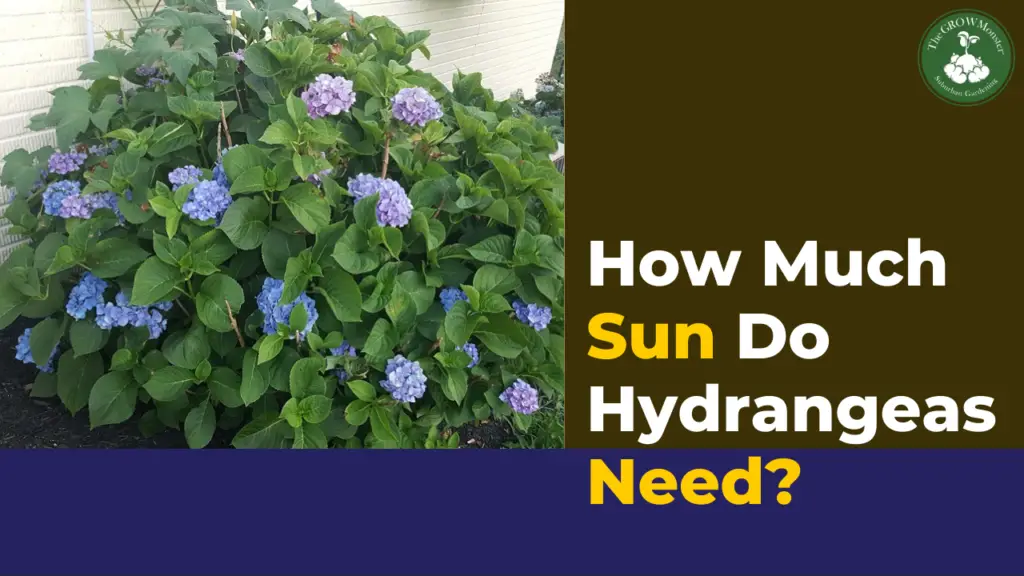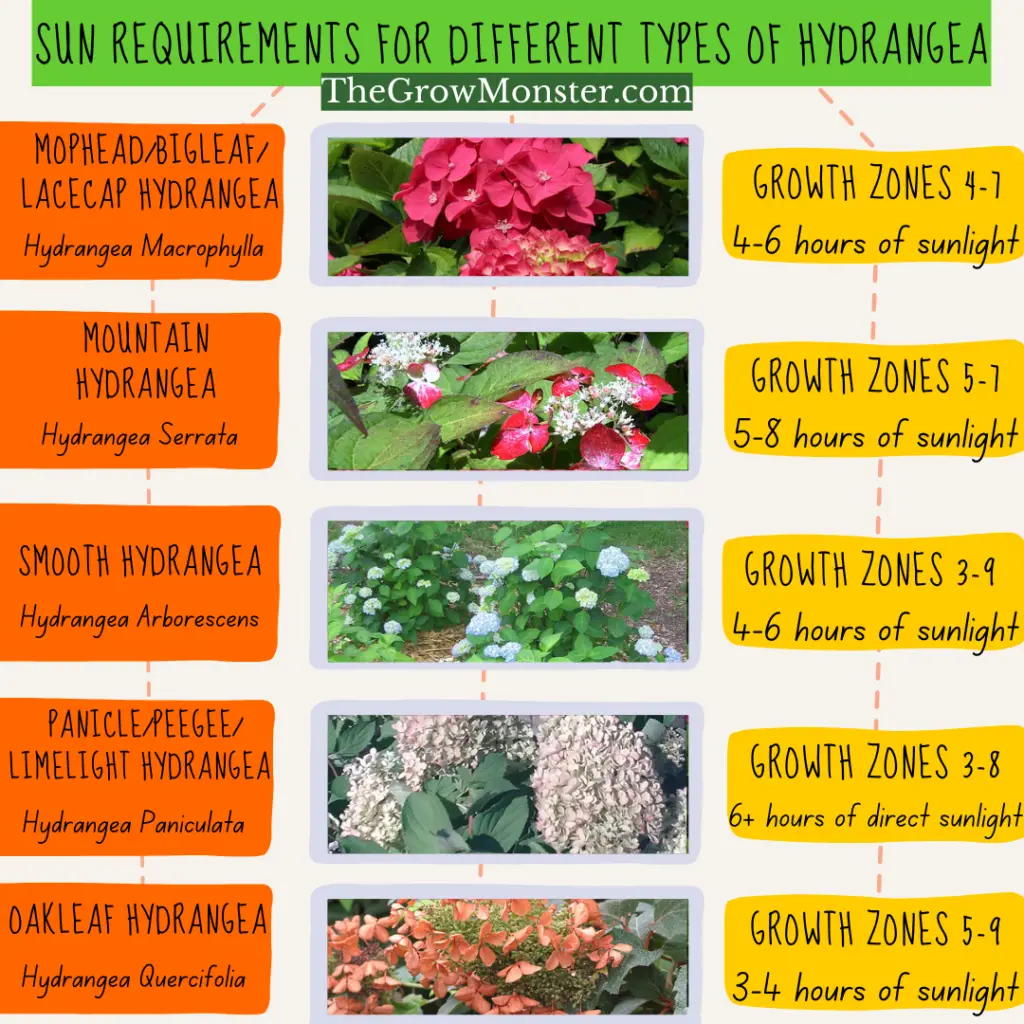Hydrangeas are a great accent shrub and can also be a good focal point in your garden. These versatile plants are beautiful and need very little care. But, how much sun do Hydrangeas need? If you want to plant them in the best area you will need to make sure they get just the right amount of sunlight and The Grow Monster is here to help you give your Hydrangeas as much sun as they need to continue giving those big beautiful blooms year after year.
Hydrangeas need on average about 4-6 hours of sun per day. Hydrangea prefer morning sun but can tolerate some direct afternoon sun if you live in a colder growing zone.
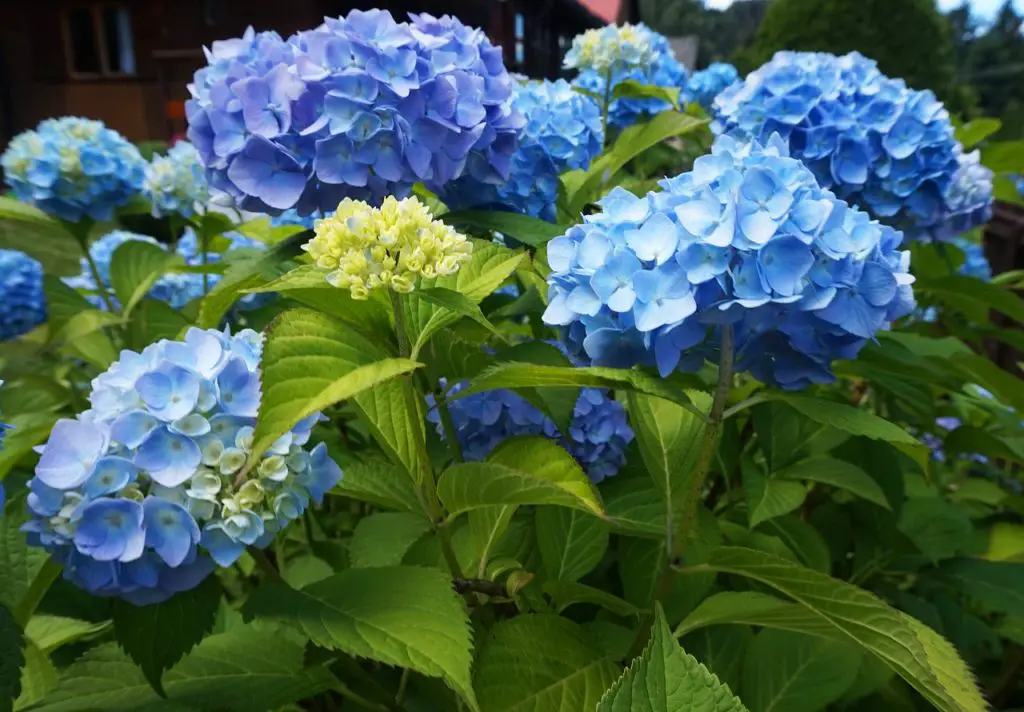
If you find yourself asking how much sun do Hydrangeas need, you have come to the right place to learn all about Hydrangea sun requirements to live a healthy, bloom-filled life. Some zones Hydrangeas can tolerate more direct sun and others they will need only morning sun. Read on to learn which sun requirements are needed in your area.
How Much Sun do Hydrangeas Need?
Hydrangeas are hardy in growing zones 3-7 and will need at least 4-6 hours of sun a day. They can get by on 4-6 hours if they are located in partial shade. If you don’t know which growing zone you are located, check out this interactive USDA hardiness zone map here. Keep in mind the lower your growing zone, the more hours of sun your Hydrangea can handle.
Different types of Hydrangea will require different amounts of sun, and this varies also depending on your growing zone. The Grow Monster has created a handy chart do you to easily see how much sun do Hydrangeas need based on this two variables (click on the chart to enlarge for easy reading).
Hydrangea Macrophylla
Hydrangea Macrophylla, also known as “mophead,” “bigleaf,”” or “French” Hydrangea, are the most popular type of Hydrangea. Lacecap Hydrangeas also fall in to this category. Hydrangea Macrophylla is known to have one of the lesser amount of direct sunlight requirements. They can be planted in partial shade and prefer morning sun with less direct afternoon sunlight. Bigleaf Hydrangea do best in zones 4-7 and require 4-6 hours of direct sunlight a day.
Hydrangea Serrata
Hydrangea Serrata, often called Mountain Hydrangea, is originally found in the cooler hillsides of Japan and Korea. Hydrangea Serrata is less susceptible to cold and not tolerant off direct sun. Hardy in growing zones 5-9, Mountain Hydrangea prefer partial shade and require 5-8 hours of sun per day. The warmer growing zones need less hours of sun per day compared to the cooler growing zones.
Hydrangea Arborescens
Hydrangea Arborescens, referred to as “smooth” Hydrangea is hardy in zones 3-9. Smooth Hydrangea is very cold hardy compared to the other types of Hydrangea. Because Hydrangea Arborescens does well in cooler temperatures, the plant prefers partial shade. If you are growing in a warmer zone, you can get away with about 4. hours of direct sun. On average, Smooth Hydrangea require 4-6 hours of sun per day.
Hydrangea Paniculata
Hydrangea Paniculata, which are the Panicle Hydrangea have varieties known as “peegee” and “limelight.” These Hydrangea are the most sun tolerant and do well in growing zones 3-8 (Limelight, zone 9). You may wonder how much sun do Hydrangeas need if they are more sun tolerant, and the Hydrangea Paniculata do need 6+ hours of direct sun, so it is more than an average amount for Hydrangea.
Hydrangea Quercifolia
Hydrangea Quercifolia, also known as Oakleaf Hydrangea, have a different style of leaf compared to the other Hydrangea varieties. The leaves look similar to Oak leaves, which is where it gets the nickname “Oakleaf.” These Hydrangea are very shade tolerant and can even be planted in full shade only needing 3-4 hours of sun per day. They do well in very little direct sunlight and are hardy in zones 5-9.
Do Hydrangeas do well in sun?
Hydrangeas, like all plants, need sunlight to live. But, do Hydrangeas do well in sun? Hydrangeas do well in morning sun and will tolerate more direct afternoon sunlight in the cooler growing zones. Some Hydrangeas need more hours of sunlight than other types, but it is always a good rule of thumb to give Hydrangeas more morning sun compared to hours of direct afternoon sun.
| Hydrangea Name | Growth Zone | Sunlight Requirements |
| Hydrangea Macrophylla (Mopleaf/Bigleaf/Lacecap) | Zones 4-7 | 4-6 hours of Sunlight |
| Hydrangea Serrata (Mountain) | Zones 5-7 | 5-8 hours of Sunlight |
| Hydrangea Arborescens (Smooth) | Zones 3-9 | 4-6 hours of Sunlight |
| Hydrangea Paniculata (Panicle) | Zones 3-8 | 6+ hours of direct Sunlight |
| Hydrangea Quercifolia (Oakleaf) | Zones 5-9 | 3-4 hours of Sunlight |
In the wild, Hydrangeas can be found on the edges of forest and woodland areas. They thrive in the dappled sunlight created by the tree canopy above. This allows some of the direct sun to get through to the Hydrangea, but really most of the sun they receive will be in the morning. This same effect can be created by planting your Hydrangea near the tree-line if you live on a wooded property or on the North or Northeast side of your home/garage/structure.
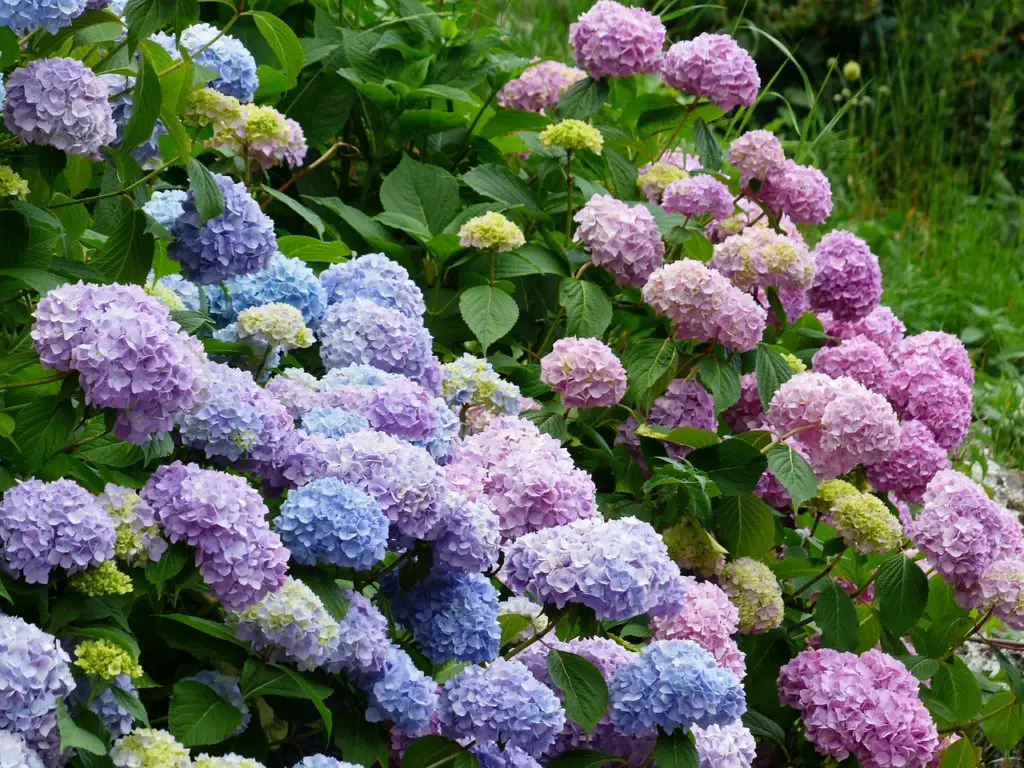
If you do have an area that only gets direct afternoon sun or sun most of the day, there are a few things you can do to help your Hydrangea thrive. Foremost, plant the Panicle Hydrangea variety because this variety, especially the Peegee and Limelight types, tolerates the most sun- and even does well in direct afternoon sunlight. They have a higher sun requirement than the other varieties of Hydrangea, needing at least six hours of sunlight a day.
If you must plant one of the other varieties, you can do the following to help them thrive better in more sun. Make sure to water your Hydrangea well, especially watering from the base to not get the leaves wet. Varieties like the bigleaf Hydrangea will start to wilt in the middle of the day with too much sun. The extra water can help keep them growing well, but be warned they might not have as many blooms as they would in a shadier spot.
Can you plant hydrangeas in shade?
Knowing that Hydrangeas need on average 4-6 hours of sun per day, can you plant Hydrangeas in the shade? Hydrangeas do really well in shade, since they usually grow on the forest edges and in woodland areas. Some areas might be shadier than others, but as long as the Hydrangea is getting morning sun for that average amount of time, it should do well.
If you have a very shady spot, under a tree or on the North side of a home obstructed from the morning sun, you might wonder how much sun do Hydrangeas need in this shady location. You can choose a more shade tolerant variety like the Oakleaf Hydrangea which can actually be planted even in full shade, especially in the warmer growing zones. If you need to check which growing zone you are located in, you can put your zip code in the USDA map here.

Hydrangeas look really good with a line of Hostas in front since both plants do well in shady areas. Many people will line the front of their houses that are facing North with this layered effect when they want to be able to have flowers versus some non-flowering shrub or bush to give interest. Another plant that goes well with Hydrangeas are Azaleas or Rhododendron since all do well in the shade. You can layer your garden area so that there is always a shrub in bloom throughout the year.
Can Hydrangeas get too much sun?
Since Hydrangeas do better in morning sun than direct afternoon sun, too much sun can harm the plant. When you ask can Hydrangeas get too much sun you need to take in to account what part of the day the plant is getting most of its sunlight, the direction the sun is coming from, and watch for any signs of too much sun. Hydrangeas prefer more morning sun vs direct afternoon sun. And will require less sun the higher your growing zone.
If your Hydrangea is in a shadier location, like a north-facing part of your house or under some trees then your Hydrangea should not have any issues getting too much sun. You can plant pretty much any variety and not have any sun-related problems. If the location you plant your Hydrangeas has a lot of sun, especially direct afternoon sun, there are a few things to watch for to tell if your Hydrangea is getting too much sun. A Hydrangea may be getting too much sun if the soil is always dry, the leaves are curled or wilted, or if the leaves appear burned at the edges.
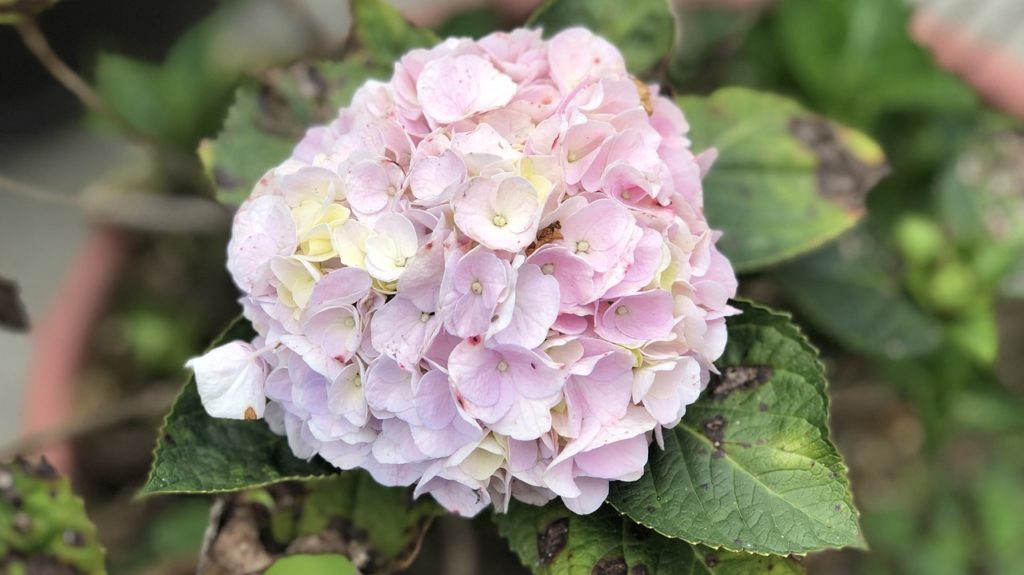
If your soil is always dry around the base of the Hydrangea, it may be getting too much sun. Watering more often can help combat the drying out of the soil and covering the area around the base with mulch and help maintain a higher moisture level. Watering during the cooler parts of the day can also help to combat dry soil at the base of your Hydrangea. The Grow Monster prefers to mulch areas around the base of our plants for not only moisture retention but other added benefits of reducing weeds and feeding the soil once the mulch breaks down.
If you notice your Hydrangea leaves wilting or curling during the day, especially during the hotter afternoon times, then it may be in a location with too much sun. When you think about how much sun do Hydrangeas need, you also have to consider how much sun is too much for a Hydrangea. The leaves will often-times tell us if the plant is getting too much sun. You can try to keep the area around the base more moist, but take care not to make it too wet otherwise the Hydrangea will become susceptible to root rot.
Note
If the soil at the base of the plant has enough water but the leaves are still wilted, then you should consider there is too much sun on it.
The last tell-tale sign of a Hydrangea with too much sun is the edges or tips of the leaves looking burnt. Burned edges and tips of leaves is called “leaf scorch” and occurs when there is too much sun on a plant that prefers more shade. You can cut off the burnt leaves, but if many are suffering from leaf scorch then the health of the entire plant is at stake. The best remedy for a Hydrangea receiving too much sun is to transplant it to a more suitable, shadier location. If your area does not have such a location, then you might want to consider a different variety of Hydrangea that does well in heavier sun.
The Panicle Hydrangea, with varieties such as “Limelight” and “Peegee,” are known to do well in higher levels of sun and with more direct sunlight in the afternoon hours of the day. If you have a very sunny area then check out these varieties because they are the most sun tolerant Hydrangeas and will do better and be healthier plants in your garden with higher direct afternoon sunlight.
Can Hydrangeas Bloom in Full shade?
Since Hydrangeas prefer morning sun and can even do well in a shady area, how much sun do Hydrangeas need in a shadier spot of your garden? A fully shaded area of the garden is considered to get less than 4 hours of direct sunlight a day. Since there are some varieties of Hydrangea- most notably the Oakleaf Hydrangea that can handle as little as 3 hours of sunlight a day, you can get a Hydrangea to bloom in full shade. The Smooth Hydrangea and Bigleaf Hydrangeas can also tolerate as little as 4 hours of direct sunlight so can be placed in full shade.
The higher your growing zone number, the more shade the Hydrangea will naturally want in the later parts of the afternoon. This means if you leave in the south you may want to specifically look for a shadier spot for your Hydrangea to prevent some of the problems mentioned when a Hydrangea gets too much sun.

If you plant your Hydrangea in a full shade area, there are a few considerations and factors to watch out for your plants. First, if you just planted your Hydrangea you may not get flowers the first year- so always wait an extra year for your plant to adjust to its new location before trying to move it again. You will want to watch if your Hydrangea has weak stems, too much moisture in the soil and problems with the leaves, and if you have had it for 2 blooming seasons and it has not produced any flowers.
If, after 2 seasons your Hydrangea is still not blooming it might be because it is not getting enough sun. The easiest way to fix this is if the sunlight is being blocked by a nearby tree just go ahead and trim the branches to allow more sunlight to reach your Hydrangea. You will know how much sun do Hydrangeas need based on the variety, as shown in the chart above, if your variety needs more sun than it is getting in that spot and it just will not flower than you should think about a better location to transplant it in your garden.
If you notice your Hydrangea looking weak, wilty branches, branches easily breaking and leaves falling off then check the moisture of the soil around the base of the plant. If there is too much shade and the area retains a lot of water then your Hydrangea will not be a healthy plant. You can solve this by aiding in the drainage of the soil or letting more sunlight on the soil to help dry it out between watering/rain. A Hydrangea likes lots of water but does not like to sit in water, which will make it susceptible to root rot and other moisture related problems.
The last thing to look for is the health of the Hydrangea leaves. Just like Hydrangeas getting too much sun, a Hydrangea getting too much sun may develop wilting and yellowing leaves, even some brown spots. These spots, yellow leaves, and wilting can be caused by fungal problems that develop from too much moisture in the shady area of your garden. A Hydrangea with poor leaves is also more susceptible to damage from pests. If your Hydrangea is not doing well in a shady area, then transplant it to a better location in your garden that has the correct amount of sunlight for the variety.
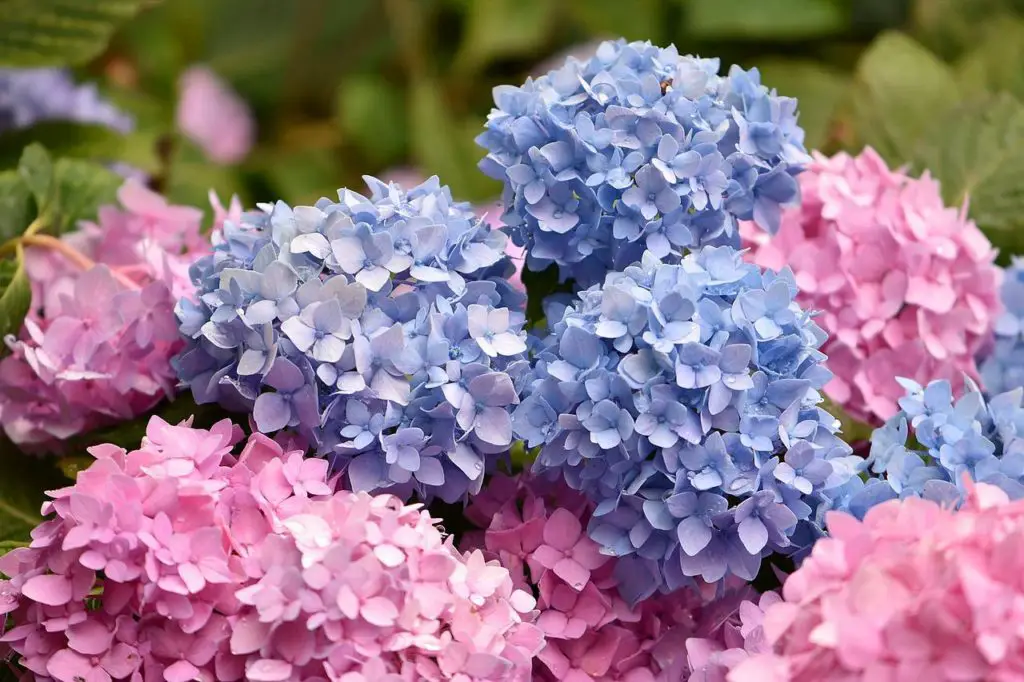
Final Thoughts
Hydrangeas have beautiful and huge flowers all throughout their blooming season. How much sun do Hydrangeas need varies per variety. If you make sure to plant your Hydrangea in a place that will ensure it gets the correct amount of sun for its variety then your plant should flourish for years to come. If you know how much sunlight your Hydrangea needs, read this article next to make sure you plant your Hydrangea in the best place in your garden.

